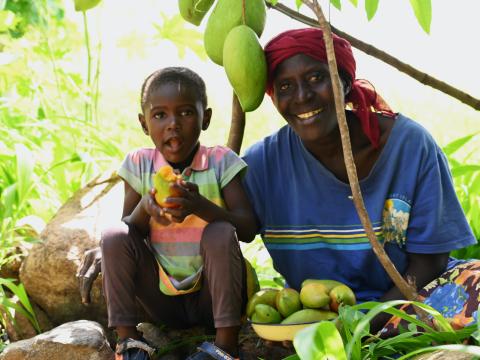Trees help family to restore degraded land and thrive during prolonged droughts

By Hellen Owuor, Communications Officer, World Vision Kenya
Joyce Wanyama, a farmer in her early 50s lives with her husband, Edward Wafula and four-year old granddaughter, Blessing in Emsea village, which is situated in Kenya’s Elgeyo Marakwet County. The family’s love for farming and fruits made them relocate from Kitale to the area in 2014.
“We moved here after discovering that there were fruit trees that could do well in this area compared to Kitale where we used to live before,” she says.

Joyce explains that since their interest was in farming, they cleared all the vegetation including beneficial shrubs on their two-acre plot of land that was majorly filled with an invasive weed, Lantana camara, which is commonly known as the Spanish flag. What was left behind was bare, degraded land with deep gullies.
“At the time, we didn’t know that we were causing more damage. Also, I later came to realise that we were residing in an area affected by lightning and strong winds that frequently swept away our roofs.”
Elgeyo Marakwet County is among the Arid and Semi-Arid (ASAL) areas in Kenya where the livelihoods of communities are threatened due to land degradation and the impacts of climate change that cause drought, flash floods and landslides in the area.

World Vision, through the Central Rift Farmer Managed Natural Regeneration Scale-Up Project (CRIFSUP) has been building the resilience of communities to these climate-induced disasters through initiatives that boost their food security and improve their livelihoods.
The focus has been on a low-cost reforestation technique known as the Farmer Managed Natural Regeneration (FMNR) that is helping communities to restore degraded lands and solve some of the key environmental challenges they are facing.
Joyce is among the 629 lead farmers that were trained on the FMNR approach by World Vision. She then cascaded the knowledge to her husband. Thereafter, they joined hands and began implementing the FMNR approach on their farm land. Six years down the line, there is undeniable joy on Joyce’s face as she talks about the approach.
“FMNR has truly changed our lives. Our mindset towards taking care of the environment has changed because we know and have experienced the benefits of trees in this homestead. Our roofs are no longer carried away by strong winds. The trees act as wind breakers,” she says.
Joyce, who occasionally prunes the trees in their farmland, says that they provide sufficient firewood for cooking all year round.

Previously she would walk for at least 14 kilometers to and fro, in search of firewood. This was time consuming and she always got home tired not having enough time to spend with her family.
Apart from firewood, she now enjoys more benefits that come with the indigenous Acacia trees such as increased soil fertility that has increased her crop yields.
Joyce grows a variety of drought tolerant crops such as beans, groundnuts, sorghum, green grams, traditional vegetables among others. These healthy nutritious crops are both for the family’s consumption and for sale, which boosts their household income.
Additionally, their farmland produces high yields of fodder and pasture that is enough for their livestock and for sale.

This year, Baringo was among the many counties in Kenya that experienced prolonged drought. When many were suffering, with increased livestock deaths and food shortage, Joyce’s family was well prepared. She had stored surplus hay for her livestock in preparation for the dry season.
“For over four months, we were affected by drought. It was so severe that even if you had money, you couldn’t get vegetables at the market. Some families were forced to make tamarind juice and eat with ugali [maize meal]. However, the case was different in my home, thanks to FMNR,” Joyce says.
The family had drought resistant crops such as the black night shade, Chaya and pigeon peas that they ate during the tough times.

As an avid FMNR champion, Joyce boasts of her family’s good health thanks to eating a balanced diet. They have mature pawpaw and mango trees and have now started growing passion and orange fruits.
Blessing their granddaughter, enjoys eating mangoes. It is her favourite resting and playing spot when she comes back home from school.

“At first, I doubted whether the tiny shrubs would turn into anything beneficial even with the pruning and management as we had been taught. But now see, we have enough to feed us, our livestock and to sell for income. Had it not been for the training I received from on the FMNR approach, none of this would be in existence. Thank you, World Vision,” says Joyce.

By the end of 2021, the CRIFSUP project had reached a population of at least 33,000 men, women and children who benefitted from FMNR after the first implementation phase of the project. Now in its second phase, the project aims to improve the lives of 55,000 people by 2026 across Baringo, Elgeyo Marakwet, Nakuru and West Pokot Counties through the FMNR approach as well as other restoration techniques.